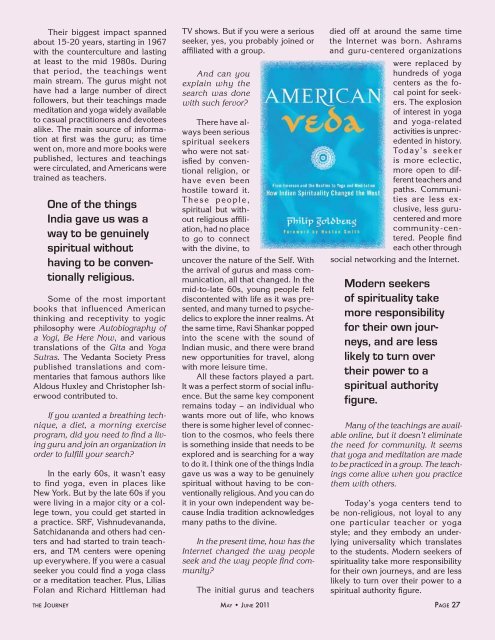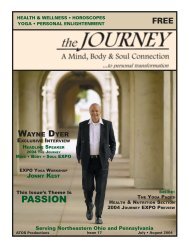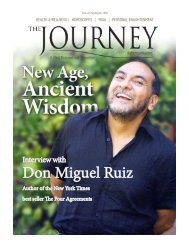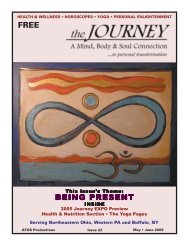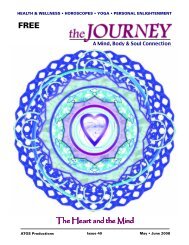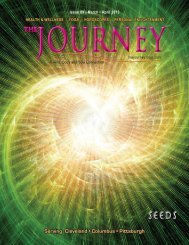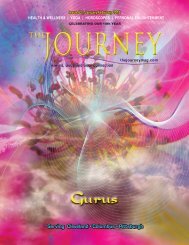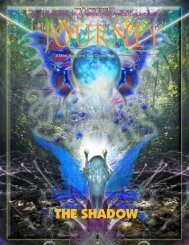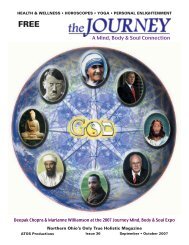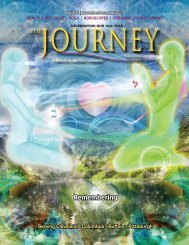May-June 2011 - The Journey
May-June 2011 - The Journey
May-June 2011 - The Journey
You also want an ePaper? Increase the reach of your titles
YUMPU automatically turns print PDFs into web optimized ePapers that Google loves.
<strong>The</strong>ir biggest impact spanned<br />
about 15-20 years, starting in 1967<br />
with the counterculture and lasting<br />
at least to the mid 1980s. During<br />
that period, the teachings went<br />
main stream. <strong>The</strong> gurus might not<br />
have had a large number of direct<br />
followers, but their teachings made<br />
meditation and yoga widely available<br />
to casual practitioners and devotees<br />
alike. <strong>The</strong> main source of information<br />
at first was the guru; as time<br />
went on, more and more books were<br />
published, lectures and teachings<br />
were circulated, and Americans were<br />
trained as teachers.<br />
One of the things<br />
India gave us was a<br />
way to be genuinely<br />
spiritual without<br />
having to be conventionally<br />
religious.<br />
Some of the most important<br />
books that influenced American<br />
thinking and receptivity to yogic<br />
philosophy were Autobiography of<br />
a Yogi, Be Here Now, and various<br />
translations of the Gita and Yoga<br />
Sutras. <strong>The</strong> Vedanta Society Press<br />
published translations and commentaries<br />
that famous authors like<br />
Aldous Huxley and Christopher Isherwood<br />
contributed to.<br />
If you wanted a breathing technique,<br />
a diet, a morning exercise<br />
program, did you need to find a living<br />
guru and join an organization in<br />
order to fulfill your search?<br />
In the early 60s, it wasn’t easy<br />
to find yoga, even in places like<br />
New York. But by the late 60s if you<br />
were living in a major city or a college<br />
town, you could get started in<br />
a practice. SRF, Vishnudevananda,<br />
Satchidananda and others had centers<br />
and had started to train teachers,<br />
and TM centers were opening<br />
up everywhere. If you were a casual<br />
seeker you could find a yoga class<br />
or a meditation teacher. Plus, Lilias<br />
Folan and Richard Hittleman had<br />
T h e Jo u r n e y<br />
TV shows. But if you were a serious<br />
seeker, yes, you probably joined or<br />
affiliated with a group.<br />
And can you<br />
explain why the<br />
search was done<br />
with such fervor?<br />
<strong>The</strong>re have always<br />
been serious<br />
spiritual seekers<br />
who were not satisfied<br />
by conventional<br />
religion, or<br />
have even been<br />
hostile toward it.<br />
T h e s e p e o p l e ,<br />
spiritual but without<br />
religious affiliation,<br />
had no place<br />
to go to connect<br />
with the divine, to<br />
uncover the nature of the Self. With<br />
the arrival of gurus and mass communication,<br />
all that changed. In the<br />
mid-to-late 60s, young people felt<br />
discontented with life as it was presented,<br />
and many turned to psychedelics<br />
to explore the inner realms. At<br />
the same time, Ravi Shankar popped<br />
into the scene with the sound of<br />
Indian music, and there were brand<br />
new opportunities for travel, along<br />
with more leisure time.<br />
All these factors played a part.<br />
It was a perfect storm of social influence.<br />
But the same key component<br />
remains today – an individual who<br />
wants more out of life, who knows<br />
there is some higher level of connection<br />
to the cosmos, who feels there<br />
is something inside that needs to be<br />
explored and is searching for a way<br />
to do it. I think one of the things India<br />
gave us was a way to be genuinely<br />
spiritual without having to be conventionally<br />
religious. And you can do<br />
it in your own independent way because<br />
India tradition acknowledges<br />
many paths to the divine.<br />
In the present time, how has the<br />
Internet changed the way people<br />
seek and the way people find community?<br />
<strong>The</strong> initial gurus and teachers<br />
died off at around the same time<br />
the Internet was born. Ashrams<br />
and guru-centered organizations<br />
were replaced by<br />
hundreds of yoga<br />
centers as the focal<br />
point for seekers.<br />
<strong>The</strong> explosion<br />
of interest in yoga<br />
and yoga-related<br />
activities is unprecedented<br />
in history.<br />
Today’s seeker<br />
is more eclectic,<br />
more open to different<br />
teachers and<br />
paths. Communities<br />
are less exclusive,<br />
less gurucentered<br />
and more<br />
community-centered.<br />
People find<br />
each other through<br />
social networking and the Internet.<br />
Modern seekers<br />
of spirituality take<br />
more responsibility<br />
for their own journeys,<br />
and are less<br />
likely to turn over<br />
their power to a<br />
spiritual authority<br />
figure.<br />
Many of the teachings are available<br />
online, but it doesn’t eliminate<br />
the need for community. It seems<br />
that yoga and meditation are made<br />
to be practiced in a group. <strong>The</strong> teachings<br />
come alive when you practice<br />
them with others.<br />
Today’s yoga centers tend to<br />
be non-religious, not loyal to any<br />
one particular teacher or yoga<br />
style; and they embody an underlying<br />
universality which translates<br />
to the students. Modern seekers of<br />
spirituality take more responsibility<br />
for their own journeys, and are less<br />
likely to turn over their power to a<br />
spiritual authority figure.<br />
Ma y • Ju n e <strong>2011</strong> Pa g e 27<br />
Ma y • Ju n e <strong>2011</strong>


